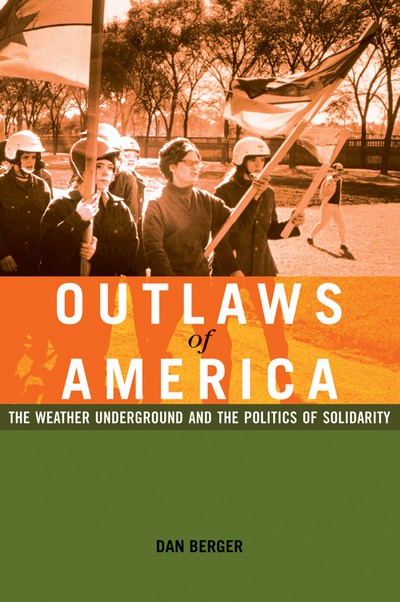Outlaws of America: The Weather Underground and the Politics of Solidarity

Revolutionary Violence and Romanticizing the Sixties
Outlaws of America:
The Weather Underground and the Politics of Solidarity
By Dan Berger
2006, AK Press, 450 pages
$20.00, paperback
Almost as pervasive as the denial, ignoring, or misinterpretation of the concept of revolutionary nonviolence is the rhetorical and romantic notion ascribed to armed struggle by much of the U.S. left. Often seen as the only true method of revolutionary change, militancy has become synonymous with military strategy and tactics, as pacifism has become, for far too many, synonymous with passivity.
The wholesale transformation of sound-alike words into simplified and incorrect analysis is nowhere as potent as in reviews of the sixties. The mythologizing of the sixties is, more and more, becoming a cottage industry in academic circles, with a growing number of published works rife with errors and exaggerations. It may be ironic, therefore, that one of the clearest, most revealing, insightful, challenging, and accurate portrayals of the period is to be found in Outlaws of America: The Weather Underground and the Politics of Solidarity by Dan Berger (AK Press, 2006) – a book about one of the most controversial groups of the period by a young scholar who did most of his research a few years ago as an undergrad.
Outlaws seeks to review a balanced history of the end of Students for a Democratic Society (SDS) and the emergence of a clandestine group of white radicals, while also presenting the story of political prisoner David Gilbert, an early SDS leader at Columbia University who spent his formative years as a committed nonviolent activist. Berger begins the book with a perspective broader than either of those goals: the idea that scholarly work on SDS, Weather, and the civil rights and anti-Vietnam War movements have typically divided the period into “a tale of two sixties” – one good and pure, the other bad and evil. The need for a more nuanced view of the sixties is a vital and important point. We must move beyond a “King-good, Malcolm-bad” (or vice versa) worldview.
In this sense, Gilbert as a reference point is a good choice; he has been and remains (behind prison walls) a writer and political analyst willing to self-critically examine the pros and cons of our movements. From 1965, when Gilbert began to question what Berger describes as “doctrinaire pacifism,” to the present day as he reflects on the macho and sectarian ways in which the Weather Underground (WUO) romanticized and glorified violence, the book connects individuals’ words and deeds, intentions and outcomes, hopes, and the historical context in which those hopes seemed reasonable.
Beyond Blame
Berger argues that a complete understanding of the sixties must get beyond “the blame game,” where the Weathermen are held responsible for the death of mass mobilization and the progressive cause. Though certainly in part responsible for the dissolution of SDS, the WUO – through all its bravado – was also key to arguing against the defeatism that portrayed all Third World peoples as victims, all Vietnamese as old men and children burned by napalm. They were also clear advocates of a staunch antiracism that put the fight by white people against white supremacy and white skin privilege at the heart of lasting social change. WUO writings foreshadowed modern discourse on the contradictions between race and class issues within the white working class. As an all-white group, they certainly fell into occasionally patronizing attitudes towards those they struggled to be in solidarity with, and Berger avoids falling into a common current trap of romanticizing Weather as the only effective antiracists. Though their practice was surely uneven, howevever, their contributions in these areas are still essential ones for today’s movement.
The role of armed tactics is carefully examined throughout Outlaws, which notes that despite sometimes outrageous rhetoric, the WUO was mainly involved in property destruction and symbolic bombings. After the infamous Townhouse explosion in which three Weather members were killed in the course of constructing a bomb, WUO took great care to organize dramatic actions that would extract real costs from the U.S. military and government while claiming no costs in terms of human life, civilian or military.
WUO’s practice contributed to the broad dialogue on the significance for and possibility of building an underground – armed or otherwise – to protect progressive movements from government attack. Despite its clandestine status, Weather engaged in discussions on these practices with the likes of Dan Berrigan, Dave Dellinger, and Timothy Leary, as well as Abbie Hoffman, though the issues of the need for an underground were most pertinent to those in the Black liberation movement, American Indian Movement, and other forces directly (and illegally) targeted for destruction through government terror. In Gilbert’s words, Weather’s most positive legacy was an ability to “pierce the myth of governmental invincibility.”
Berger’s thoroughly researched work is also designed to pierce a myth: the idea within mainstream as well as progressive circles that the story of the sixties can be reduced to one of good guys versus bad guys. Partisan to the contributions of the WUO, Berger suggests that solidarity – militant antiracism and internationalism – is the “real meaning” of the era. In a book that is breathtaking in its breadth and in its attempts to tell a truthful and useful tale, Berger is certainly on the mark when he concludes that the legacy is “fully trapped,” like Gilbert himself, behind prison doors. Rescuing the sixties, both literally through the release of the more than 100 U.S. political prisoners and figuratively through further uncompromising examination, is an urgent task for us all.
